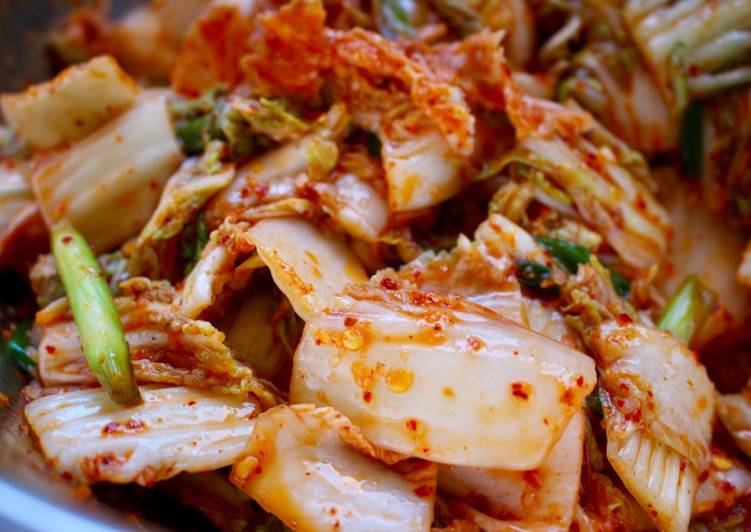Kimchi (Easier than you think! ;) ). Making Kimchi at Home Is Easier Than You Think. You can use it to flavor soups, stews or stir-fries, braise it along with short ribs, or add it to any dish you think would be perked up by a sour/spicy note. Korean food has long taken a back seat to Chinese and Japanese cuisine, and even lags behind.
 Plus it uses what are likely more accessible ingredients - fish sauce, - crushed. Making good authentic kimchi at home is much easier than you think. This list has something for everyone and every season! You can have Kimchi (Easier than you think! ;) ) using 11 ingredients and 9 steps. Here is how you achieve it.
Plus it uses what are likely more accessible ingredients - fish sauce, - crushed. Making good authentic kimchi at home is much easier than you think. This list has something for everyone and every season! You can have Kimchi (Easier than you think! ;) ) using 11 ingredients and 9 steps. Here is how you achieve it.
Ingredients of Kimchi (Easier than you think! ;) )
- You need of Napa cabbage, cut into roughly 1"x 2" pieces (about 30 cups of chopped raw cabbage).
- You need of green onions, washed, roots trimmed, and cut into 2 inch segments.
- Prepare of kosher salt (about 10% less if you're using regular table salt).
- You need of For the paste:.
- You need of minced garlic (about 5 or 6 large cloves).
- It's of minced fresh ginger root (about a 2" segment, peeled).
- It's of crushed red chili flakes depending on how hot you want your kimchi. See notes above re: gochugaru.
- It's of steamed white rice, lightly packed. Short or long grain is fine. If stale, microwave with 2 Tbsp. water for 1 minute.
- Prepare of fish sauce.
- You need of sugar.
- Prepare of water for blending + 1/3 cup water for rinsing seasoning from bowl (see directions below).
In late fall, Korean households make a large batch of traditional napa cabbage kimchi (배추), also called pogi kimchi (포기김치), to last through the winter and early spring. And once you've made a batch it's a versatile way to bring spicy, lacto-fermented goodness to a range of delicious dishes. Versatility aside, Choi thinks that more people should be eating kimchi because of its health benefits: Kimchi is naturally probiotic (like most fermented foods), and packed with Vitamin D. Machine Project hosts some of the best food events, usually at really affordable prices.
Kimchi (Easier than you think! ;) ) step by step
- In a large stainless steel or mixing bowl, toss the raw cabbage, green onion, and the salt together to pre-brine the cabbage. Make sure to thoroughly incorporate the salt throughout the cabbage. In 10 to 15 minutes, you should start to see the cabbage leach liquid and wilt. Let the cabbage sit for 1.5 to 2 hours, tossing and redistributing every 30 minutes to ensure even brining..
- After at least 90 minutes of pre-brining, rinse the cabbage with enough water to cover the cabbage by 4 or 5 inches by swishing the cabbage in the water 7 or 8 times. Remove the cabbage into a strainer and let the excess water drain while you prepare the paste..
- Make the paste by putting all the paste ingredients into a blender and blend until you can't see the individual grains of rice. Pour the paste over the cabbage..
- Get into the bowl with your hands and mix the paste into the cabbage until all the pieces are evenly and thoroughly coated..
- Pack your kimchi into a clean, dry bottle or other tight-lidded container (this time I repurposed a half gallon kimchi jar) and use the last 1/3 cup of water to swish around the mixing bowl, pick up all the remaining paste, and pour that liquid on top of your kimchi. Remember to leave 2 to 3 inches of headspace at the top to allow for expansion as fermentation takes place..
- Your batch of kimchi is now ready for fermentation in a dark but not cold place like the inside of your cupboard. Or, if you can find a warmish spot in your garage, you can put it there. (I know that's not always possible for cold climate people in the middle of winter.) As it ripens, it's a good idea keep the lid slightly unscrewed to relieve the pressurization caused by fermentation. (Your jar can literally explode from the pressure on a specially active fermentation day.).
- People often ask HOW RIPE DOES THE KIMCHI HAVE TO BE BEFORE I REFRIGERATE OR EAT IT? You can eat the kimchi whenever you want. Fresh, just after it's been made, all the way up to when it's so incredibly old, ripe and stinky you could choke out a subway system by placing an open jar in one of the vents. It remains safe for human consumption for A VERY LONG TIME..
- But as to when to refrigerate, just go out once a day every day to taste a piece, and when it gets to the ripeness you like, stick it in the fridge. It'll continue to ripen, but very slowly..
- Enjoy! :).
Kimchi is the iconic dish of Korean cuisine and has been gaining popularity worldwide in the past decade or so for its health benefits and its just plain deliciousness. It Is Easier Than You Think! Join for FREE and see the results! Chock full of vitamins and pro-biotics, this mak kimchi is the perfect healthy side dish for any Korean meal. Good authentic homemade kimchi is much easier than you think.
Comments
Post a Comment